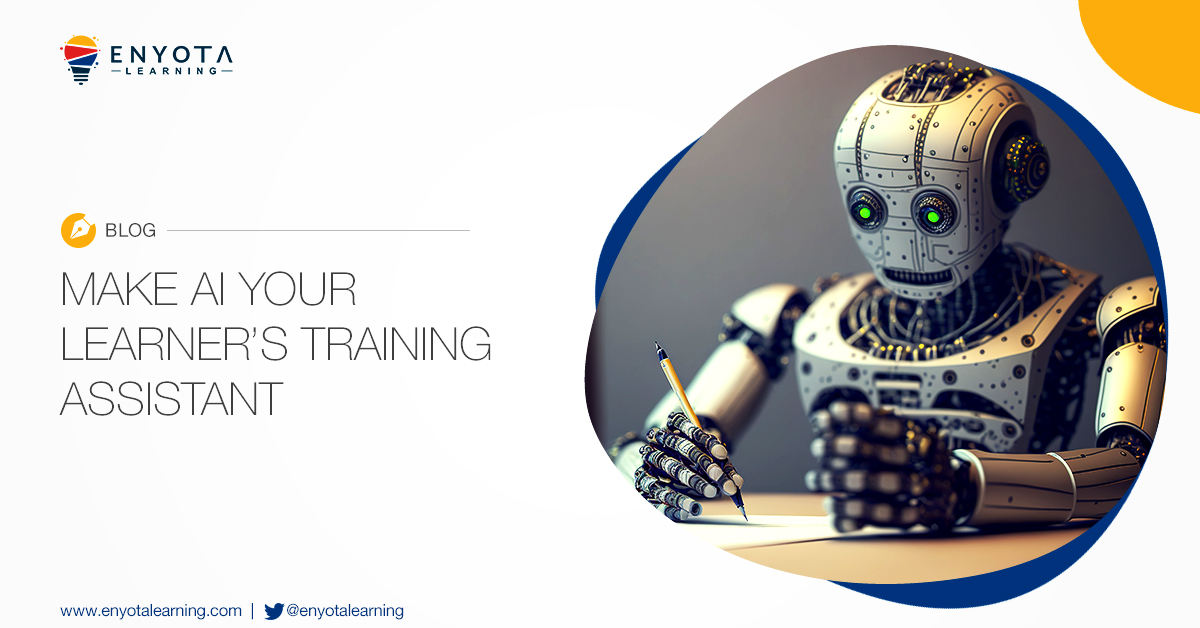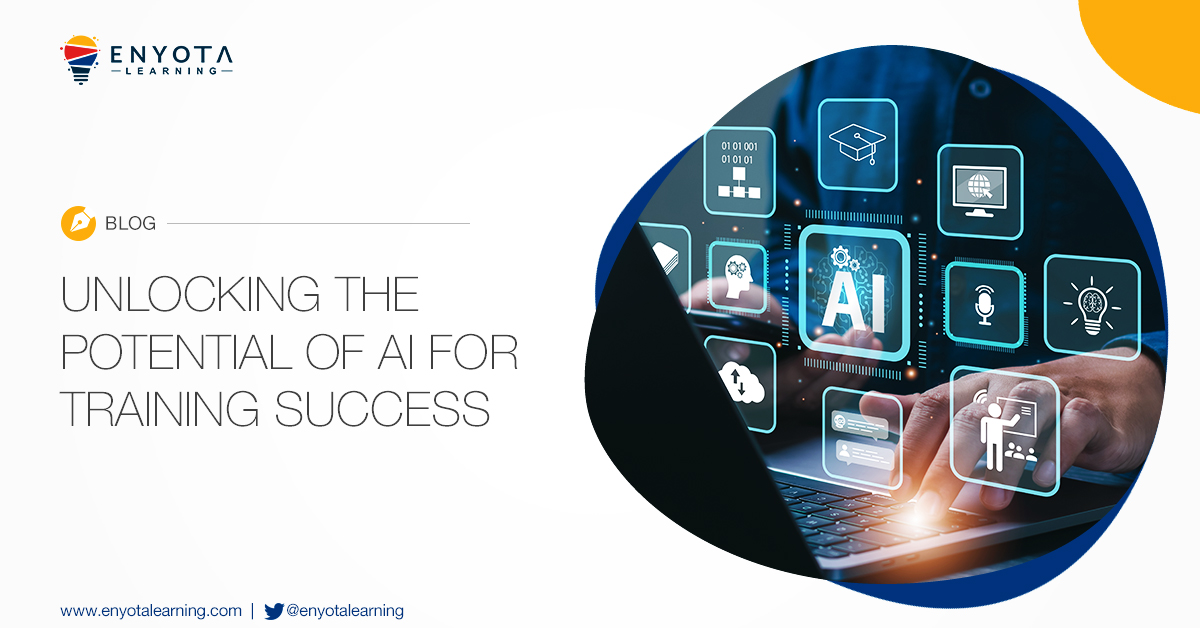So, we have already discussed about AI’s role in building the training of the future, we spoke about how AI is ‘not’ that magical wand that can conjure up a swanky eLearning course in a matter of minutes. We have also discussed the dangers of AI bias and discrimination against learners when the AI is not trained correctly. If you go through these articles, you’ll realize that AI has great potential to be an assistant and a part of your training and development initiatives, but implementing AI in your training initiatives or even using AI to build training is not as easy as it is made to appear.
However, AI is here to simplify lives, right? So there has to be an area in training and development that can directly and effectively benefit from the powers of AI. There has to be an area where AI and training blend so seamlessly and so easily that any L&D department can integrate AI in their training, right? Well, there actually is an area where AI can immediately and effectively turn your training upside down, and we mean in a great way!
If your training was previously unengaging, or was overly complicated making learners avoid it, or it lacked the personal touch like what classroom training provides, it’s all going to change! What we are going to discuss is so big and so promising that eLearning or self-paced training is going to completely change once and for all. That is because you can now ask AI to become your learners’ ‘private training assistant,’ and AI will be more than happy to do so!
AI as Your Learners’ Training Assistant
If you aren’t as excited about this as we are, you may not have completely understood our excitement!
AI technology is currently available for businesses to integrate into any of their products and services. Since AI is designed to communicate with people and answer questions, what’s better than using AI enabled chatbot/assistants to assist with training learners?
Think about it. You can now build a custom eLearning course and integrate AI either into the course itself or integrate it into your learning management system where the course is hosted. Learners can then access this training and if a topic confuses learners or stalls their progress, all the learners must do is ask the AI to simplify the topic or subject.
AI Chatbots in eLearning Design!
We know about interactive eLearning elements, now think about the same interactive eLearning designs with AI powered ‘click to reveal’ elements. Or AI chatbot assistant panels that are ever present by your learners’ sides as they browse through the training, ready to answer any doubt that learners face with regards to the training, even going above and beyond to simplify or elaborate on a topic to ensure that the learner is now deriving maximum potential from the training!
All of this is not wishful thinking, it’s possible and it’s already happening. Tools like ChatGPT are currently available from the developers themselves to be readily integrated into your products, and your eLearning-based training courses are the best place to get started.
Is It Difficult to Implement AI Chatbot Assistants in Training?
Integrating AI chatbots assistants into eLearning can be a relatively simple or complex process, depending on the specific needs of the organization and the chatbot platform being used.
Key steps to integrate a chatbot assistant successfully into your training:
-
Choose the right chatbot assistant platform
There are several different chatbot platforms available, each with its own strengths and weaknesses. It is important to choose a platform that is well-suited to the specific needs of your organization and learners.
-
Train the chatbot/assistant
The chatbot assistant must be trained using accurate, non-biased, and nondiscriminatory data in order to be able to accurately answer questions and aid without being controversial in any way. This data can include text, images, and videos.
-
Deploy the chatbot/assistant
Once the chatbot assistant is trained and ready to go, it can be deployed on the organization’s website or learning management system.
-
Who Can Implement AI Chatbot Assistants in eLearning?
Anyone with technical skills in programming languages such as Python or Java, and chatbot frameworks, such as Dialogflow or Rasa can implement an AI chatbot assistant into your eLearning framework!
The only important point to consider is understanding the AI chatbot assistant’s limitations. No AI is perfect, so it is important to be aware of AI limitations. For example, the chatbot assistant may not be able to answer all questions or provide assistance with all tasks.
AI Chatbot Assistants: Enhancing Learners’ Training Experience
AI chatbot assistants can do a variety of things for learners, including:
-
Answer questions
AI chatbots assistants can answer questions about course material, assignments, and other topics related to the training. This can help learners train more effectively and efficiently.
-
Provide assistance
AI chatbots assistant can provide assistance with tasks such as logging in to the learning management system, submitting assignments, and accessing course materials. This can help learners to save time and frustration.
-
Motivate and encourage
AI chatbot assistants can motivate and encourage learners by providing positive feedback, offering suggestions, and helping them to set goals. This can help learners stay on track and achieve their goals.
-
Personalize the learning experience
AI chatbots can personalize the learning experience by tailoring the content and delivery of the instruction to the individual learner’s needs and preferences. This can help learners learn more effectively and efficiently. Read more about Adaptive Learning.
-
Track progress
AI chatbots can track learner progress and provide feedback to learners. This can help learners identify areas where they need additional help and track their overall progress.
-
Provide recommendations
AI chatbots can provide recommendations for additional resources, such as articles, videos, and other learning materials. This can help learners continue their learning beyond the course.
Overall, AI chatbot assistants can be a valuable tool for learners. They can provide support, assistance, motivation, and personalization, all of which can help learners learn more effectively and efficiently.
Additional Benefits of Using AI Chatbot Assistants
-
24/7 availability
AI chatbots assistants are available 24 hours a day, 7 days a week, which means that learners can get help whenever they need it.
-
Convenience
AI chatbot assistants can be accessed from anywhere with an internet connection, which means that learners can get help without having to travel to a physical location.
-
Affordability
AI chatbots are typically more affordable than traditional forms of support, such as live chat or phone support.
If you are looking for a way to improve the learning experience for your learners, consider using AI chatbot assistants. They can provide a variety of benefits that can help learners to learn more effectively and efficiently.
About eNyota Learning
If you are interested in transforming your training content and engaging your learners, you can contact us anytime or write to us at contact@enyotalearning.com. We look forward to hearing from you soon. Also, test our LMS free for 30 days at Abara LMS.





